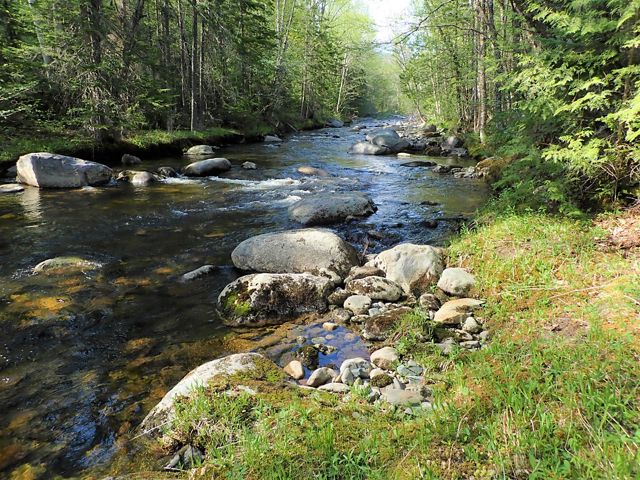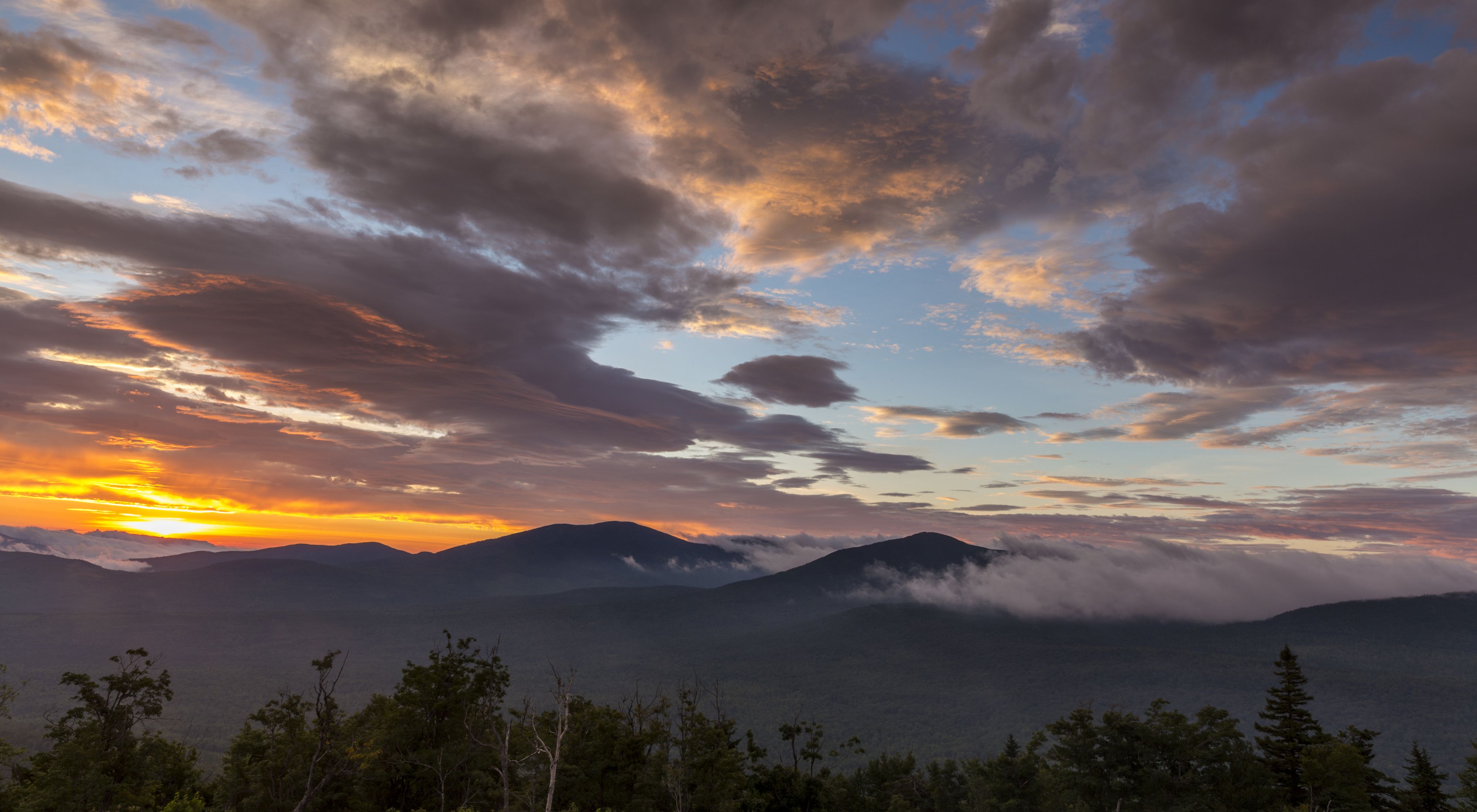Critical 13,640-Acre Section of Western Maine Protected
Trust for Public Land, The Nature Conservancy and the State of Maine ensure outdoor access and climate resilience in Maine’s Western Mountains.
Media Contacts
-
Jeremy Cluchey
Maine Director of Public Affairs
Phone: 207-607-4843
Email: jeremy.cluchey@tnc.org
Two key properties totaling 13,640 acres in the Western Maine Mountains—Quill Hill and Perham Stream—have been permanently protected. All of the acreage will be open for public use, and a majority will continue to be managed with timber harvests. This conservation project was led by Trust for Public Land (TPL), The Nature Conservancy (TNC) in Maine and the State of Maine’s Bureau of Parks and Lands. Public funding was awarded through the Land and Water Conservation Fund Forest Legacy Program, which is administered by the U.S. Forest Service, and the Department of Defense’s Readiness and Environmental Protection Integration program.
These lands are part of the traditional territory and of ongoing cultural significance to the Wabanaki People. They are also key parts of a priority landscape for enhancing carbon storage and ensuring species can adapt to a changing climate. Quill Hill and Perham Stream are vitally important to the region’s economy, outdoor recreation, forest products industry, climate resilience, wildlife habitat, healthy watersheds and quality of life. They are prominent in the landscapes visible from the Appalachian Trail, Mt. Abraham and the Rangeley Lakes Scenic Byway and are adjacent to the wilderness training facility operated by the U.S. Navy in Redington Township.

The 7,062-acre Quill Hill property—just 10 minutes from Rangeley—is a well-known destination that welcomes 30,000 visitors a year, drawn to its 360-degree view of the Western Maine Mountains that is easily accessible to all. The property also features a universally accessible trail system and other recreational trails and complements nearby outdoor recreational resources, including the Northern Forest Canoe Trail and Saddleback Ski Area; Quill Hill is a prominent feature of the view from Saddleback, and vice versa. The Quill Hill property will continue to be owned by the Brochu family, with the property available for continued timber harvest, and is now permanently protected via a conservation easement held by the State of Maine and the U.S. Navy.
The 6,578-acre Perham Stream property was purchased from Bayroot, LLC by the Maine Bureau of Parks and Lands, and there is now a conservation easement on the property held by the U.S. Navy. On the slopes of the 4,802-foot Mt. Abraham, the property features a mountainous bowl around Farmer Mountain and two headwater streams in the Kennebec River watershed that provide important cold-water habitat—Perham Stream in the Sandy River watershed and Quick Stream in the Carrabassett River watershed. Entirely open to public recreation as part of Maine’s Public Reserve Lands system, almost 5,000 acres is designated as an addition to the ecological reserve on Mt. Abraham, while the remaining nearly 1,600 acres will be available for timber harvest by the Bureau.
Lead funding for the Quill Hill to Perham Stream effort came from the United States Forest Service Forest Legacy Program, with additional support from the U.S. Department of Defense Readiness and Environmental Protection Integration Program, and the generous support of private individuals and foundations including RA Capital, the EJK Foundation, The Betterment Fund, the Appalachian Trail Conservancy’s Wild East Fund and the Maine Mountain Collaborative Transaction Fund.
Quote: Governor Janet Mills
I’m thrilled that future generations will be able to experience the unmatched beauty of the Western Maine mountains from Quill Hill to Perham Stream.
“I’m thrilled that future generations will be able to experience the unmatched beauty of the Western Maine mountains from Quill Hill to Perham Stream,” said Governor Janet Mills. “This extraordinary, collaborative conservation project will preserve access to some of the most breathtaking vistas in the state and set aside thousands of acres of land for recreation and wildlife habitat that will benefit generations to come. I thank the Trust for Public Land and The Nature Conservancy for partnering with the Bureau of Parks and Land to make this extraordinary achievement possible.”
“By opening access to the Quill Hill and Perham Stream properties, we’re helping to link more than 100,000 acres of public lands along the Appalachian National Scenic Trail to mitigate climate impacts and ensure access to the outdoors for all,” said Betsy Cook, Maine state program director for Trust for Public Land. “This space will be truly open to all, with ADA accessible viewing areas and hiking and outdoor recreational opportunities for every ability level, and TPL is proud to work with project partners to protect this incredible landscape.”
“Conserving Quill Hill to Perham Stream is a critical step forward for Maine’s climate resilience and a case study in collaborative conservation,” said Kate Dempsey, state director of The Nature Conservancy in Maine. “Over the past four years, the support and commitment of the private landowners, public agencies, local businesses, more than two dozen conservation and economic development organizations, and Maine’s congressional delegation have been vital to the success of this project.”
“This collaborative project contains all the key elements that reflect Maine’s vision for conservation: a privately owned working forest that supports Maine’s timber economy, ecological reserves that sustain biodiversity, and multiple-use public land that will benefit people and wildlife for generations to come,” said Maine Bureau of Parks and Lands director Andy Cutko.

“To say that my late husband, Adrian, loved Quill Hill is an understatement,” said Celine Brochu. “He thought about Quill all the time. In the winter, he would read every single comment left in the guest books, making his own notes in the margins. He spent long summer days at Quill—smoothing rough spots on the road, moving countless rocks, taking breaks to chat with visitors. Quill Hill always held a very special place in his heart. And mine. He often talked about how he wanted Quill Hill to be open and accessible to everyone forever. I am incredibly proud of all he accomplished and so grateful that our family and all the project partners including TPL, TNC, the State of Maine, the U.S. Forest Service and the U.S. Navy have realized his vision and permanently protected Quill Hill.”
“The permanent conservation of these lands protects the wilderness environment the Navy relies on for realistic training, preserving wildlife habitat and preventing incompatible development near the base,” said Capt. Michael Oberdorf, shipyard and installation commander at Portsmouth Naval Shipyard. “We are proud to be part of such a successful effort that supports mission readiness while increasing access to outdoor recreation and advancing the region and Maine’s climate resiliency and conservation goals.”
“The state of Maine is blessed with an abundance of natural resources, which offer both its residents and visitors the opportunity to experience and appreciate the pristine environment that surrounds them,” said Senators Collins and King and Representative Golden. “It is imperative that we protect these resources, like Quill Hill and Perham Stream, from development and ensure future generations can continue to enjoy and connect with nature across our state.”
“Our nation’s forests provide immeasurable social, economic and environmental benefits that are lost when forestland is converted to non-forest uses,” said Gina Owens, regional forester for the USDA Forest Service’s Eastern Region. “The Forest Service’s Forest Legacy Program directly supports our partners in pursuing mutual forest conservation objectives for the benefit of future generations.”
About Trust for Public Land
Trust for Public Land (TPL) is a national nonprofit that works to connect everyone to the benefits and joys of the outdoors. As a leader in equitable access to the outdoors, TPL works with communities to create parks and protect public land where they are needed most. Since 1972, TPL has protected more than 4 million acres of public land; created more than 5,364 parks, trails, schoolyards and iconic outdoor places; raised $93 billion in public funding for parks and public lands; and connected nearly 9.4 million people to the outdoors. To learn more, visit tpl.org.
About The Nature Conservancy in Maine
The Nature Conservancy (TNC) is a global conservation organization dedicated to conserving the lands and waters on which all life depends. Guided by science, TNC works in 76 countries and territories and uses a collaborative approach that engages local communities, governments, tribes, the private sector and other partners. Co-founded in 1956 by Rachel Carson, TNC Maine has helped protect almost 2.5 million acres and currently owns and manages more than 300,000 acres in the state. To learn more, visit www.nature.org/maine or follow @TNCMaine on social media.
The Nature Conservancy is a global conservation organization dedicated to conserving the lands and waters on which all life depends. Guided by science, we create innovative, on-the-ground solutions to our world’s toughest challenges so that nature and people can thrive together. We are tackling climate change, conserving lands, waters and oceans at an unprecedented scale, providing food and water sustainably and helping make cities more sustainable. Working in more than 70 countries and territories, we use a collaborative approach that engages local communities, governments, the private sector, and other partners. To learn more, visit nature.org or follow @nature_press on Twitter.
